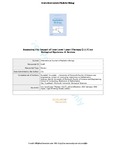Assessing the impact of low level laser therapy (LLLT) on biological systems: a review
| dc.contributor.author | Mussttaf, RA | |
| dc.contributor.author | Jenkins, D | |
| dc.contributor.author | Jha, Awadhesh | |
| dc.date.accessioned | 2019-01-21T10:12:57Z | |
| dc.date.available | 2019-01-21T10:12:57Z | |
| dc.date.issued | 2019-02-01 | |
| dc.identifier.issn | 0955-3002 | |
| dc.identifier.issn | 1362-3095 | |
| dc.identifier.uri | http://hdl.handle.net/10026.1/13174 | |
| dc.description.abstract |
PURPOSE: Low level laser therapy (LLLT) in the visible to near infrared spectral band (390-1100 nm) is absorption of laser light at the electronic level, without generation of heat. It may be applied in a wide range of treatments including wound healing, inflammation and pain reduction. Despite its potential beneficial impacts, the use of lasers for therapeutic purposes still remains controversial in mainstream medicine. Whilst taking into account the physical characteristics of different qualities of lasers, this review aims to provide a comprehensive account of the current literature available in the field pertaining to their potential impact at cellular and molecular levels elucidating mechanistic interactions in different mammalian models. The review also aims to focus on the integral approach of the optimal characteristics of LLLT that suit a biological system target to produce the beneficial effect at the cellular and molecular levels. METHODS: Recent research articles were reviewed that explored the interaction of lasers (coherent sources) and LEDs (incoherent sources) at the molecular and cellular levels. RESULTS: It is envisaged that underlying mechanisms of beneficial impact of lasers to patients involves biological processes at the cellular and molecular levels. The biological impact or effects of LLLT at the cellular and molecular level could include cellular viability, proliferation rate, as well as DNA integrity and the repair of damaged DNA. This review summarizes the available information in the literature pertaining to cellular and molecular effects of lasers. CONCLUSIONS: It is suggested that a change in approach is required to understand how to exploit the potential therapeutic modality of lasers whilst minimizing its possible detrimental effects. | |
| dc.format.extent | 1-24 | |
| dc.format.medium | Print-Electronic | |
| dc.language | en | |
| dc.language.iso | en | |
| dc.publisher | Taylor & Francis | |
| dc.rights | Attribution-NonCommercial 4.0 International | |
| dc.rights | Attribution-NonCommercial 4.0 International | |
| dc.rights | Attribution-NonCommercial 4.0 International | |
| dc.rights | Attribution-NonCommercial 4.0 International | |
| dc.rights | Attribution-NonCommercial 4.0 International | |
| dc.rights | Attribution-NonCommercial 4.0 International | |
| dc.rights | Attribution-NonCommercial 4.0 International | |
| dc.rights | Attribution-NonCommercial 4.0 International | |
| dc.rights.uri | http://creativecommons.org/licenses/by-nc/4.0/ | |
| dc.rights.uri | http://creativecommons.org/licenses/by-nc/4.0/ | |
| dc.rights.uri | http://creativecommons.org/licenses/by-nc/4.0/ | |
| dc.rights.uri | http://creativecommons.org/licenses/by-nc/4.0/ | |
| dc.rights.uri | http://creativecommons.org/licenses/by-nc/4.0/ | |
| dc.rights.uri | http://creativecommons.org/licenses/by-nc/4.0/ | |
| dc.rights.uri | http://creativecommons.org/licenses/by-nc/4.0/ | |
| dc.rights.uri | http://creativecommons.org/licenses/by-nc/4.0/ | |
| dc.subject | DNA damage | |
| dc.subject | DNA repair | |
| dc.subject | Low level laser therapy (LLLT) | |
| dc.subject | cell proliferation | |
| dc.subject | light emitting diodes (LEDs) | |
| dc.title | Assessing the impact of low level laser therapy (LLLT) on biological systems: a review | |
| dc.type | journal-article | |
| dc.type | Journal Article | |
| dc.type | Research Support, Non-U.S. Gov't | |
| dc.type | Review | |
| plymouth.author-url | https://www.ncbi.nlm.nih.gov/pubmed/30614743 | |
| plymouth.issue | 2 | |
| plymouth.volume | 95 | |
| plymouth.publication-status | Published | |
| plymouth.journal | International Journal of Radiation Biology | |
| dc.identifier.doi | 10.1080/09553002.2019.1524944 | |
| plymouth.organisational-group | /Plymouth | |
| plymouth.organisational-group | /Plymouth/Admin Group - REF | |
| plymouth.organisational-group | /Plymouth/Admin Group - REF/REF Admin Group - FoSE | |
| plymouth.organisational-group | /Plymouth/Faculty of Science and Engineering | |
| plymouth.organisational-group | /Plymouth/Faculty of Science and Engineering/School of Biological and Marine Sciences | |
| plymouth.organisational-group | /Plymouth/Faculty of Science and Engineering/School of Engineering, Computing and Mathematics | |
| plymouth.organisational-group | /Plymouth/REF 2021 Researchers by UoA | |
| plymouth.organisational-group | /Plymouth/REF 2021 Researchers by UoA/UoA06 Agriculture, Veterinary and Food Science | |
| plymouth.organisational-group | /Plymouth/REF 2021 Researchers by UoA/UoA12 Engineering | |
| plymouth.organisational-group | /Plymouth/Research Groups | |
| plymouth.organisational-group | /Plymouth/Research Groups/Marine Institute | |
| plymouth.organisational-group | /Plymouth/Users by role | |
| plymouth.organisational-group | /Plymouth/Users by role/Academics | |
| plymouth.organisational-group | /Plymouth/Users by role/Researchers in ResearchFish submission | |
| dc.publisher.place | England | |
| dcterms.dateAccepted | 2018-08-24 | |
| dc.rights.embargodate | 2020-1-7 | |
| dc.identifier.eissn | 1362-3095 | |
| dc.rights.embargoperiod | Not known | |
| rioxxterms.versionofrecord | 10.1080/09553002.2019.1524944 | |
| rioxxterms.licenseref.uri | http://creativecommons.org/licenses/by-nc/4.0/ | |
| rioxxterms.type | Journal Article/Review |



